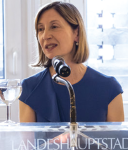Dr. van der Heijde described the awards ceremony as wonderful and recalls when she first learned that she would receive the Carol Nachman Prize.
“That was a very special moment because I didn’t so much expect it,” she notes. “I think especially what I like is that it’s your peers that select you for the prize.”
I think it is very good to see what has been done over the years is finally recognized by the community of rheumatologists.
—Andres Radbruch, PhD
Memory and Inflammation
Andres Radbruch, PhD, scientific director of the Rheumatism Research Center Berlin in Berlin, Germany, was selected for the prize as a nod to his research that contributed important insights on the role of immunological memory in inflammatory rheumatic diseases, according to the trustees of the Carol Nachman Prize. “His studies have led to a new understanding of the immunological memory and opened up avenues to new therapies,” the trustees said in a news release announcing the winners.
More specifically, the selection committee sited Dr. Radbruch’s work on long-lived memory B and T cells. Both cell populations are potential target cells for the development of new drugs for autoimmune diseases, including rheumatic diseases.
Dr. Radbruch began his scientific career as an immunologist and scholar of Klaus Rajewsky in Cologne, Germany, where he developed an interest in cytokine expression of T cells, which play a major role in the immune system.
His early research started with the idea that there is something like pathologic memory, says Dr. Radbruch. The concept grew out of clinical observation of experimental therapies that reset immune systems by first destroying them in patients with rheumatic diseases and then rebuilding them with stem cell therapy.
Such therapies have often led to long-term remission of disease, and their success indicated to researchers that there was something in the immune system that drove the disease in these systems, explains Dr. Radbruch. The renewed immune system that had no memory for the disease is tolerant and unable to regenerate the disease.
“So that was the argument of why we actually focused on memory,” says Dr. Radbruch.
His research ultimately led to the conclusion that plasma cells can be long-lived memory cells that are maintained in the bone marrow and rest in specific survival niches. Along with the discovery came the realization that these niches, formed by stroma cells from the marrow, provide a safe harbor for long-lived plasma cells.

